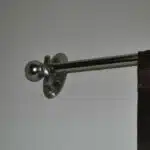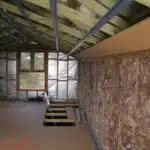As a window treatment expert, I have often come across individuals struggling to measure their windows for curtains. This common problem can lead to ill-fitting curtains that do not serve their intended purpose of providing privacy and blocking out sunlight. Measuring your window correctly is essential to ensure that your curtains fit perfectly and enhance the overall aesthetic appeal of your home.
Accurate measurement of a window for curtains requires precision and attention to detail. It is crucial to take into account the type of curtain rod you intend to use, the desired length and width of the curtain panel, and any other factors that may affect the final outcome. In this article, we will explore how to measure a window for curtains in a simple and straightforward manner, allowing you to achieve perfect results every time. By following these steps, you will be able to create beautiful window treatments that complement your decor while serving their practical purpose effectively.
Tools You’ll Need
As a window treatment expert, it’s always amusing to see how often people mismeasure their windows when trying to install curtains. Before anything else, you’ll need two things: a measuring tape and a step ladder. The first is self-explanatory, but the latter is necessary for getting accurate measurements from higher-up windows.
When measuring your window for curtains, precision is key. Start by measuring the width of your window from one side to the other, making sure to write down the measurement as you go. Next, measure the height of your window from top to bottom in the same way. It’s important not to guesstimate and be as precise as possible since even slight deviations can result in ill-fitting curtains.
Once you have your measurements recorded, it’s time to move on to choosing the right curtain rod. Keep in mind that this decision will impact both the aesthetic and functionality of your window treatment, so choose wisely.
Choosing The Right Curtain Rod
When it comes to choosing the right curtain rod, there are a few things to consider. Firstly, you need to think about the type of curtains you have or plan to buy. Different types of curtains require different types of rods. For example, if you have heavy drapes, you will need a rod that can support their weight.
Secondly, decorative finials can add a touch of style and personality to your window treatment. These decorative end pieces come in a variety of shapes and sizes, from simple spheres to ornate designs. When choosing finials, make sure they complement the overall style of your room.
Thirdly, consider the material of the rod itself. Curtain rods can be made from wood, metal, or plastic. Wood rods are great for adding warmth and texture to a room while metal rods are more modern and sleek. Plastic rods are lightweight and easy to install but may not be as durable as their wooden or metal counterparts.
• Are you looking for a classic or modern look? Choose a rod that matches your desired aesthetic. • Want to add some personality? Look for unique finials. • Have heavy curtains? Make sure your rod is sturdy enough to support them. • Short on space? Try installing tension rods instead of traditional ones.
Choosing the right curtain rod is an important step in creating a beautiful window treatment for your home. By considering factors such as the type of curtains you have, decorative finials, and material options, you can create a cohesive look that complements your personal style and enhances your living space. Next up: measuring the width of your window to ensure your curtains fit perfectly.
Measuring The Width Of Your Window
- When measuring the width of a window for curtains, it is important to have the necessary measurement tools such as a tape measure or ruler.
- The style of window will also affect the type of measurements taken and the installation method used.
- For example, a single hung window requires measurements that are different from those of a sliding glass door.
- It is also important to consider the type of installation for the curtains, such as whether they will be mounted inside or outside the window frame.
- If installed outside the frame, the measurement will need to be larger to account for the space between the frame and the curtains.
- For the best results, it is best to take multiple measurements and then average the results.
Measurement Tools
Measuring the width of a window is crucial in determining the right size of curtains to fit. As a window treatment expert, I understand the importance of measuring accuracy when it comes to window treatments. Precision is key when it comes to ensuring that your curtains fit perfectly on your windows. This is why it’s essential to use reliable measurement tools when measuring your window.
One tool that can help you achieve accurate measurements is digital measurement tools. These tools are designed to provide precise measurements, making them ideal for measuring the width of windows. They eliminate the need for manual measurements, which can be prone to errors, and are easy to use. With digital measurement tools, you can measure your window width with ease and confidence.
When using digital measurement tools or any other measuring tool, it’s important to ensure that you take multiple measurements for accuracy. Measuring only once can lead to imprecise measurements, which may result in curtains that don’t fit properly on your windows. To avoid this, measure your window at least three times and take an average of the measurements obtained. Doing so will guarantee that you get accurate measurements and ultimately perfect-fitting curtains for your windows.
Window Styles
Measuring the width of your window is essential in determining the right size of curtains. However, it is also important to consider the style of your window when choosing the appropriate curtains. Differentiating between casement and bay windows is crucial in selecting the right style for your home décor.
Casement windows are hinged on one side and open outward, while bay windows have multiple panels that project from the wall. When measuring a casement window, it’s important to take into account the width of the frame, as this will affect the size of the curtains needed. On the other hand, with bay windows, you need to measure each panel separately as they have different widths.
Choosing curtains that complement your window style can enhance the overall look of your home décor. Whether you opt for classic or contemporary styles, make sure that your choice blends well with your window and room design. Measuring accurately and selecting suitable curtains based on window style can make all the difference in achieving a polished look for your home interior.
Installation Types
When it comes to window treatments, measuring the width of your window is just the first step. Once you have determined the correct size of curtains, you need to consider installation types that will best suit your needs. There are two main installation types: inside mount and outside mount.
Inside mount installation involves mounting the curtain rod inside the window frame. This option provides a clean and streamlined look while maximizing natural light and showcasing decorative molding or trim around the window. On the other hand, outside mount installation involves hanging the curtain rod above or beyond the window frame, creating a grander look for larger windows or adding height to a room. Ceiling mount and wall mount are two variations of outside mount installation that offer different benefits depending on your space.
Ceiling mount installation involves attaching the curtain rod to the ceiling instead of a wall. This creates an illusion of higher ceilings, making it perfect for rooms with low ceilings. Wall mount installation, on the other hand, offers more flexibility in adjusting curtain length and allows for layering with other window treatments like blinds or shutters. Determining which installation type best suits your space will depend on factors like ceiling height, window shape and size, and personal preference for design style.
Measuring The Length Of Your Window
To ensure that your curtains hang properly, measuring accuracy is key. In the previous section, we discussed how to measure the width of your window. Now, let’s move on to measuring the length. This step is just as important as measuring the width, and skipping it can result in curtains that are too short or too long.
When measuring the length of your window for curtains, consider the impact of the window sill. If you want your curtains to hang all the way down to the floor, measure from the top of the window frame to the floor. However, if you prefer your curtains to end at or above the window sill, then measure from where you want them to hang down to either the windowsill or floor. Keep in mind that adding a few extra inches will allow for any hemming adjustments needed.
Once you have taken measurements for both width and length, double-checking your measurements is essential. Make sure you have written down accurate numbers and review them before purchasing any curtains. Taking proper measurements ensures a perfect fit for your new curtains and will save you time and money in returns or alterations later on.
Double-Checking Your Measurements
Did you know that one of the most common mistakes people make when measuring windows for curtains is not using the proper measuring tools? It’s true. Many people use a tape measure that is either too short or too long, which can lead to inaccurate measurements. To avoid this mistake, invest in a high-quality tape measure that is at least 25 feet long and has both metric and imperial measurements.
Another common mistake people make when measuring windows for curtains is not taking into account the type of curtain rod they plan to use. Curtain rods come in different thicknesses, and if you don’t take this into consideration, your curtains may end up being too short or too long. To avoid this mistake, measure the thickness of your curtain rod before taking any window measurements.
Lastly, double-check your measurements before purchasing any curtains. It’s easy to make mistakes when measuring windows, so it’s important to double-check your work before making any purchases. Take your time and re-measure each window several times to ensure accuracy. By following these tips and avoiding common measurement mistakes, you can ensure that your curtains fit perfectly and add a touch of elegance to any room in your home.
Now that you have mastered the art of measuring windows for curtains without making common mistakes, it’s time to move on to calculating the curtain panel size. This step involves determining how many curtain panels you will need based on the size of your windows and the desired amount of fabric fullness. Don’t worry; we will guide you through this process step by step in our next section.
Calculating The Curtain Panel Size
After double-checking your measurements, it’s time to calculate the curtain panel size. Calculating panel width is crucial in ensuring that the curtains fit perfectly on your window. To do this, add 4-8 inches to the width of your window frame. This measurement accounts for the amount of fabric needed for proper coverage and fullness.
Once you have determined the panel width, it’s time to choose the right fabric. Fabric selection plays a significant role in achieving the desired look and function of your curtains. Opt for lightweight fabrics like cotton or linen if you want a breezy and relaxed feel in your space. For more privacy and light control, heavier fabrics like velvet or blackout curtains are ideal.
When choosing a fabric, consider its maintenance requirements as well. Some fabrics require dry cleaning while others can be machine washed at home. It is also important to take into account any potential fading or shrinkage that may occur after washing or exposure to sunlight. By taking these factors into account, you can ensure that your curtains will not only look great but also last for years to come.
To achieve the perfect look for your windows, calculating panel width and fabric selection are key steps in the process. These steps will ensure that your curtains fit properly and serve their desired function while also adding style to your space.Choosing the right fabric involves considering several factors including maintenance requirements and durability, among others. With these tips in mind, you can confidently select the best fabric for your curtains and enjoy beautiful window treatments that enhance your home’s décor.
Choosing The Right Fabric
As a window treatment expert, I have seen it all when it comes to fabric selection. Different fabric types can completely transform a room’s aesthetic, so choosing the right one is crucial. Some fabrics are better suited for certain window treatments than others, so it’s important to know your options. For example, heavy fabrics like velvet or chenille work well for drapes that need to insulate against cold air, while lighter fabrics like cotton or linen are great for allowing natural light in.
Once you’ve decided on the type of fabric you want, color and pattern selection is the next step. This can be overwhelming since there are countless options available. When selecting colors, consider the overall color scheme of the room and what mood you want to create with your curtains. Neutral tones like beige or gray can create a calming atmosphere while bold colors like red or blue make a statement. Similarly, patterned curtains can add texture and interest to a space but should be chosen carefully so as not to clash with other patterns in the room.
When it comes down to it, choosing the perfect fabric for your curtains is about finding the balance between form and function. You want something that looks great but also performs well in terms of light control and insulation. Take your time selecting fabrics and colors that suit your needs and personal style. Once you’ve made your selections, it’s time to move onto hemming your curtains to ensure they fit perfectly on your windows.
Hemming Your Curtains
When it comes to window treatments, hemming your curtains is an essential step in achieving a polished and professional look. Hemming refers to the process of folding and sewing the bottom edge of your curtains to create a finished appearance. Before starting this process, it’s important to determine the desired length of your curtains by measuring from the top of the rod to where you want them to fall.
Once you’ve measured and marked your curtains, it’s time to begin hemming. There are several different hemming styles to choose from, including double-fold hems, blind hems, and rolled hems. Double-fold hems are ideal for heavier fabrics as they provide additional weight at the bottom of the curtain, while blind and rolled hems create a sleeker look that is perfect for lightweight fabrics.
After selecting your preferred hemming style, it’s crucial to iron your curtains before beginning any sewing. Ironing will help create crisp edges and ensure that your hem remains in place after stitching. Once you’ve completed the hemming process, take some time to carefully press your curtains again with an iron. This final step will help achieve a flawless finish that will elevate any room in which they’re placed.
Transition: Now that you’ve successfully hemmed your curtains, it’s time to move on to another important step in creating beautiful window treatments: lining them.
Lining Your Curtains
As the saying goes, “measure twice, cut once.” Before moving on to installing your curtains, it is important to discuss the benefits of curtain lining and the different types available. Curtain lining serves as an extra layer of protection for your curtains, helping to prolong their lifespan by shielding them from direct sunlight and wear and tear.
There are several types of curtain lining available, including cotton sateen, blackout lining, and thermal lining. Cotton sateen is a popular choice due to its affordability and ability to add fullness and body to your curtains. Blackout lining is perfect for those who prefer complete darkness in their rooms or need privacy during the day. Thermal lining can provide insulation during colder months by trapping heat inside your room.
The benefits of curtain lining extend beyond just protecting your curtains and providing additional functionality. They also add a touch of elegance to any room by giving curtains a fuller look and enhancing their overall appearance. Additionally, they can help regulate temperature inside your home, ultimately reducing energy costs throughout the year. Now that you understand the importance of curtain lining and the various options available, it’s time to move on to installing your curtain rod without delay!
Installing Your Curtain Rod
Proper installation of your curtain rod is essential to ensure that your curtains function correctly and enhance the overall look of your window. Before installing the rod, it is crucial to measure the width and height of your window accurately. You will need a few measuring tools, including a measuring tape, a level, and a pencil.
To begin, measure the width of your window frame from one end to the other. Add six inches to this measurement to allow for proper coverage on each side of the window when hanging your curtains. Next, measure the height from the top of the window frame to where you would like the curtains to hang. Make sure to add three inches to this measurement for clearance above the window frame.
After taking these measurements, mark where you will install your curtain brackets with a pencil. Use a level to ensure that they are straight before drilling holes into your wall or window casing. Follow proper installation techniques by using anchors if necessary and ensuring that all screws are tight and secure.
Taking accurate measurements and properly installing your curtain rod will set you up for success when it comes time to hang your curtains. With these steps complete, you can move onto selecting the appropriate hardware and style for hanging your curtains in our next section.
Hanging Your Curtains
Once you have measured your window for curtains, it’s time to think about how you want to hang them. Choosing the right materials and adjusting the height of your curtains can make a big difference in the overall look and feel of a room.
When it comes to materials, consider both practicality and aesthetics. If you want your curtains to be functional and block out light or keep in heat, opt for heavier fabrics such as velvet or wool. If you’re more concerned with appearance, lighter fabrics like silk or linen can create an elegant and airy look. Keep in mind that certain materials may require special care instructions when it comes to cleaning.
Adjusting the height of your curtains can also impact the way a room looks and feels. Hanging them higher than the actual window frame can create an illusion of height and make a small space appear larger. On the other hand, hanging them lower can create a cozy and intimate atmosphere. Be sure to take into account any furniture that may be blocking your windows before deciding on placement.
Now that you’ve chosen your materials and decided on the height, it’s time to hang those curtains! But before we get into that, let’s first discuss some important considerations for adjusting your curtains once they are up.
Adjusting Your Curtains
When it comes to window treatments, curtains are a popular choice for their versatility and aesthetic appeal. However, even the most beautiful curtains won’t look their best if they aren’t properly adjusted. Adjusting curtains can be tricky, but with the right tips and tricks, you can achieve a professional-looking finish.
One common issue that people face when adjusting curtains is unevenness. This can be caused by uneven mounting of the curtain rod or variations in the length of the curtains themselves. To solve this problem, start by measuring from the floor to where you want the bottom of your curtain to fall. If you have multiple windows in a row, make sure that all of your measurements are consistent throughout. You may also need to adjust your curtain rod height or install additional brackets for support.
Another common issue when adjusting curtains is bunching or sagging in the middle of the rod. This can be caused by too much weight on one side of the rod or improper spacing between brackets. To fix this issue, try redistributing weight by moving heavy items like valances or tiebacks to the other side of the rod. You may also need to adjust your bracket spacing to provide additional support in areas where there is more weight.
Adjusting curtains requires patience and attention to detail, but it’s well worth it for a polished look that complements your decor and enhances your privacy and comfort at home. In our next section, we’ll explore some common mistakes to avoid when adjusting curtains so that you can get it right every time and enjoy all the benefits of beautiful window treatments.
Common Mistakes To Avoid
Now that you have adjusted your curtains to the desired length, it is time to measure your window for the perfect fit. Measuring a window for curtains may seem like a simple task, but there are common mistakes that can lead to ill-fitting curtains. To avoid these mistakes and ensure that your curtains look their best, follow these tips and tricks for measuring your windows accurately.
Firstly, use a metal tape measure for accurate measurements. Avoid using cloth or plastic tapes as they tend to stretch and result in incorrect measurements. Secondly, measure the width of the window frame from left to right at three different points: the top, middle, and bottom. Use the smallest measurement as your final width measurement. Lastly, measure the length of the window from the top of the frame to where you want your curtains to end.
When measuring for curtains, it is essential to consider other factors such as curtain header styles and rod placement. For instance, if you plan on hanging pleated curtains with clip rings or hooks, add an extra 1-2 inches in length to prevent them from looking too short when hung up. Additionally, make sure that your curtain rod placement is high enough above the window frame to allow enough space for proper draping.
To summarize, measuring a window for curtains is crucial for achieving a polished look in any room. By avoiding common mistakes and following these tips and tricks mentioned above, you can ensure that your curtains fit perfectly every time.
Bullet point list:
- Use a metal tape measure for accuracy.
- Measure width at three different points and use smallest measurement.
- Consider curtain header styles when determining length.
- Add an extra 1-2 inches in length for pleated curtains with clip rings or hooks.
- Ensure proper curtain rod placement above window frame.
As an expert in window treatments, I know how important it is to take precise measurements when fitting curtains onto windows. Common mistakes can lead to curtains that are too short or long, and even worse, curtains that do not fit at all. Taking the time to measure your windows accurately can ensure that your curtains will look great and function as intended.
In the next section, we will discuss common troubleshooting tips for curtain fitting. Whether it is dealing with uneven window frames or finding the right curtain rod placement, these tips will help you overcome any obstacles in achieving a perfect fit for your curtains.
Troubleshooting Tips
Identifying the Problem: To measure a window for curtains, first identify the window’s dimensions, such as the length and width.
Analyzing the Problem: Then, consider the size of the window relative to the size of the room and how much light should be filtered through the curtains.
Finding Solutions: Determine the desired look of the curtains, such as fullness and length, and how they should be hung.
Testing Solutions: Finally, double-check measurements to ensure a correct fit and proper installation.
Identifying The Problem
As a window treatment expert, accurately measuring a window for curtains is crucial to ensuring that the final product fits perfectly and looks aesthetically pleasing. Measuring accuracy is essential in identifying the problem of ill-fitting curtains. Common errors include measuring only the width or height of the window, rather than both dimensions. This can result in curtains that are too narrow or too short for the window.
Another common error is failing to consider how much fabric will be needed to create adequate fullness when the curtains are closed. Failing to take this into account can result in curtains that appear skimpy or flat when closed. Additionally, not accounting for any hardware such as curtain rods or finials can lead to curtains that do not fit properly over the window.
Identifying these common measuring errors is vital for ensuring accurate measurements and successful installation of your curtains. As an expert in my field, I recommend taking precise measurements using a metal tape measure, starting at the top of the window frame and measuring down to where you want your curtains to end. It’s also important to measure both the width and height of your window accurately while taking into account any hardware and desired fullness. By avoiding these common mistakes and taking careful measurements, you’ll be able to create beautiful custom curtains that perfectly fit your windows.
Analyzing The Problem
As a window treatment expert, I understand that even with accurate measurements and precise installation, problems can still occur with curtains. Common mistakes in measuring and installation often result in ill-fitting or unsightly curtains. Troubleshooting these issues requires careful analysis of the problem to identify the root cause.
One common problem is curtains that hang unevenly or do not have consistent fullness. This may be due to uneven or incorrect placement of curtain hardware, such as rods or brackets. By analyzing the positioning of the hardware and adjusting it accordingly, this issue can often be resolved.
Another troubleshooting tip is to address any issues with wrinkles or creases in the fabric. Sometimes ironing or steaming alone may not be enough to remove stubborn folds in the material. In this case, it may be necessary to re-hang the curtains and adjust their placement for a smoother appearance.
By identifying these common mistakes and offering troubleshooting tips for resolving them, I hope to empower my audience to create beautiful custom curtains that perfectly fit their windows. With careful attention and analysis, any issues with ill-fitting or unsightly curtains can be resolved for a flawless end result.
Final Thoughts
Decorating options for your windows are endless, and curtains are a classic choice that can add both style and function to any room. However, before purchasing curtains, it is important to measure your window correctly to ensure the right fit. Measuring your window for curtains may seem daunting at first, but with a few simple steps, you can achieve the perfect look for your home.
Firstly, it is essential to measure the width of your window accurately. To do so, measure the length of your curtain rod or track and add approximately four inches on either side. This will allow for adequate coverage of your window frame while maintaining a full look when the curtains are drawn closed. Next, measure the height of your window from the top of the frame to where you would like the curtains to end. Depending on your desired style, you may opt for floor-length curtains or shorter styles that sit just above the windowsill.
When choosing curtain styles for your home, there are several factors to consider. The fabric type and pattern will impact how much light enters a room as well as its overall aesthetic appeal. Heavier materials such as velvet provide greater insulation and privacy while lighter fabrics such as linen or sheer create an airy atmosphere in a space. Additionally, selecting curtain styles such as pinch pleat or grommet can also influence how they hang on your windows and complement other design elements within a room.
In summary, measuring windows for curtains may seem like a daunting task but following simple steps will help ensure an accurate fit. When selecting curtain styles consider factors such as fabric type and pattern to create an appealing look that complements other decor elements within a space. With these tips in mind, anyone can achieve beautiful results when decorating their windows with curtains.
Conclusion
As a window treatment expert, it is important to understand how to measure a window for curtains. Choosing the right curtain rod and measuring the width and length of your window are crucial in ensuring that your curtains fit properly and look great. Double-checking your measurements and adjusting your curtains may be necessary, but common mistakes can be easily avoided with proper guidance.
When measuring your window, don’t forget to consider other factors such as the type of fabric you plan to use and whether you want your curtains to hang above or below the window sill. Troubleshooting tips are also helpful if you encounter any issues during the installation process. By following these steps and taking into account all relevant factors, you can achieve a beautiful look that adds style and elegance to any room.
In conclusion, measuring a window for curtains may seem intimidating at first, but with the right tools and knowledge, it can be a simple process. As a window treatment expert, I encourage you to take the time to measure carefully and avoid common mistakes. With some patience and attention to detail, you can create an inviting space that is both functional and aesthetically pleasing. Remember that every detail matters when it comes to creating the perfect environment in your home!
Image Credits
- “Images Through a Bus Window #7: Peering between the curtains” by FotoGrazio (featured)





























